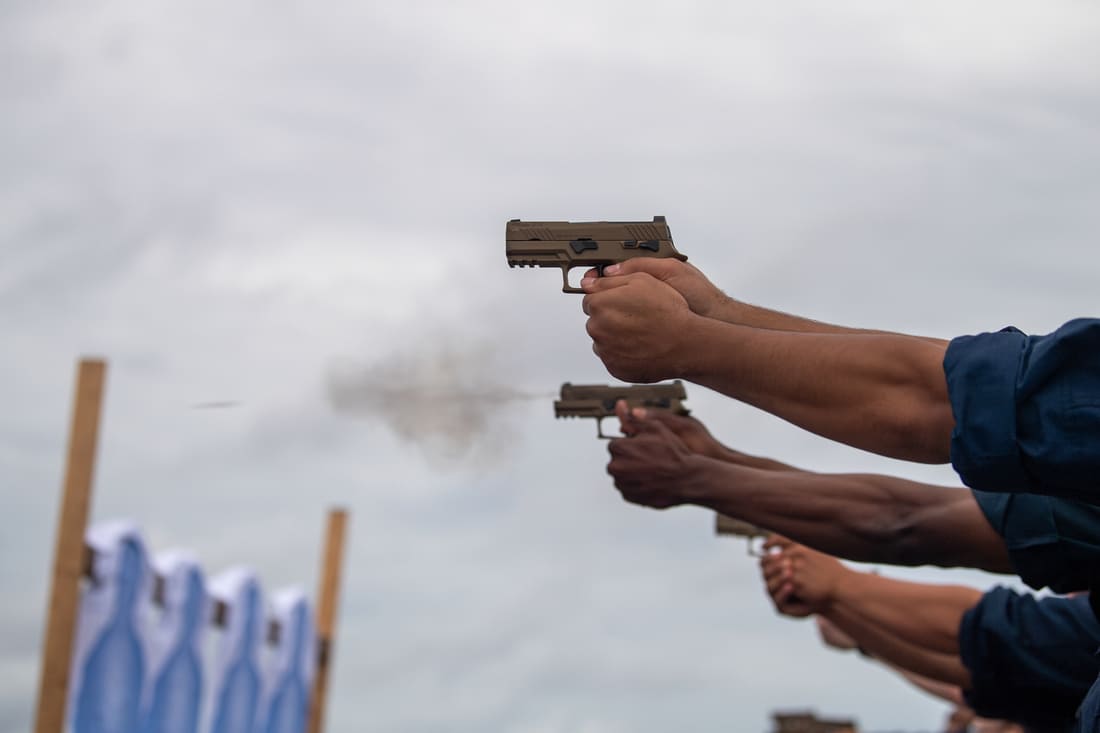The U.S. Air Force has ordered a service-wide, 100% inspection of all M18 sidearms after a 21-year-old Security Forces airman died on July 20 at F.E. Warren Air Force Base, Wyoming. The move expands a previously announced pause inside Air Force Global Strike Command and applies across the force while investigators examine the circumstances that led to the fatal discharge. Defense officials confirm that commanders have prioritized immediate safety checks and temporary substitutions where needed to sustain mission coverage.
The death occurred on July 20. The Air Force identified the airman as Airman 1st Class Brayden Lovan, assigned to the 90th Security Forces Squadron at F.E. Warren. The case remains under investigation by the Air Force Office of Special Investigations. The service released the name on July 25.
A directive dated July 21-circulated within Global Strike units-ordered every M18 under that command inspected by Combat Arms personnel and pulled the pistol from operational and training use until further notice. The memo told units to issue rifles instead to maintain duties while checks proceed. Charles Hoffman, spokesperson for Air Force Global Strike Command, confirmed the pause took effect July 21.
On August 1, Air Force leaders extended the effort and directed a service-wide safety inspection of M18 handguns. That direction covers the 125,000 M18 pistols in Air Force inventory and runs in parallel with the ongoing investigation.
The wider Air Force response now reaches beyond Global Strike Command. Some Air Combat Command units have imposed their own temporary restrictions on M18 use while they verify condition and configuration. Headquarters did not mandate a command-level pause for every ACC unit, but local commanders have authority to restrict use while they complete checks.
The M18, the compact member of the military’s Modular Handgun System family derived from the Sig Sauer P320, replaced the Beretta M9 across the Department of the Air Force. Air Force procurement documents from 2020 put the planned buy at about 125,000 pistols for Air Force requirements. Fielding started several years ago and expanded to units that carry sidearms as part of daily duty, most notably Security Forces and many aircrew positions.
What the inspection order does, and what units are doing now
The order requires each unit with assigned M18 pistols to account for every serial number, verify mechanical function, and document any deficiencies. Security Forces Combat Arms instructors lead the checks. The checks include the slide assembly, striker components, trigger function, takedown lever, and safeties, with special attention to wear, damage, and parts substitution. Units that rely on sidearms for routine duties have moved to rifles where policy permits.
Global Strike’s July 21 directive laid down the immediate steps. It told Security Forces across the command to inspect 100% of M18 handguns and to use the M4 rifle as the substitute sidearm for daily mission coverage until commanders lift the pause. That measure remains in effect inside Global Strike.
Service-wide, the August 1 push scales inspection beyond the nuclear enterprise and bomber community. The wider action ensures uniform documentation of pistol condition for units under Air Education and Training Command, Air Mobility Command, Air Combat Command, and other major commands that maintain M18s. According to industry sources, several large training wings set aside additional Combat Arms range days this week to move pistols through detailed checks and function tests without slowing initial skills training.
The scale of work is significant. The Air Force controls the majority share of the military’s M18 inventory across the services, which places the heaviest administrative burden on Air Force Combat Arms flights and unit armorers. The workforce has experience with large fleet checks, but the tempo of inspections and paperwork requires schedule adjustments at some bases.
Implications for missions, aircrew, and training
Security Forces remain the most affected community because they carry handguns daily for base defense and law-enforcement duties. Commanders have shifted posture to rifles where policy allows. Patrol tactics adjust accordingly, with vehicles configured for long guns and with additional clearing procedures at facility entry control points. Defense officials confirm that duty rosters and pre-shift checks now include extra time for weapon issue, clearing, and storage because the rifle is larger and requires a different sling and vehicle mount.
Aircrew communities that carry M18 pistols as part of survival gear have faced a different problem set. The Air Force lab-tested the M18 for ejection-seat forces when it adopted the pistol for aircrew. Until commanders conclude the current checks, survival kits in some squadrons now omit the pistol or substitute other approved options to reduce risk during sorties. The change preserves flight operations while the investigation and inspections proceed.
Training pipelines have kept graduation timelines intact. Where pistol ranges were scheduled, units in the inspection queue have shifted to classroom blocks or other small-arms requirements. According to industry sources, instructors have prioritized inspection throughput for pistols scheduled for near-term qualification cycles to avoid reworking entire course plans.
What the investigation covers, and what it does not
The Air Force has not released a cause of death. Investigators have focused on the specific pistol, its maintenance history, the holster and sustainment parts, and the environment at the scene. The Air Force Office of Special Investigations is leading the case with support from Security Forces and safety specialists. Sig Sauer has stated on multiple occasions that the P320 family-which includes the M18-cannot fire unless the trigger moves to the rear. The company’s public statement reads: “The P320 CANNOT, under any circumstances, discharge without the trigger first being moved to the rear.”
Commanders have not suggested a permanent change to the Air Force’s sidearm program. The current order is a safety action meant to establish the condition of every M18 in the Air Force inventory and to capture any out-of-tolerance parts or improper configurations. The Army, Navy, and Marine Corps have not adopted a service-wide pause, though they continue to review developments.
Why risk managers care about configuration control
Most M18s in the fleet came from the Modular Handgun System contract awarded in 2017. The Air Force buy centered on a compact sidearm with a consistent trigger and modular grip sizes. Configuration control matters because aftermarket parts or minor substitutions can alter tolerances or fit, and because improper assembly can degrade safety margins. The July 21 Global Strike memo speaks directly to that point through the 100% inspection requirement and the immediate pull from use until checks are done.
Units are validating serial-number records against the Defense Property Accountability System and local armory ledgers. Instructors are logging inspection findings in maintenance systems used for small-arms sustainment. That approach creates traceability for future audits and reduces repeat work if the investigation identifies a specific component for replacement. Defense officials also note that range staff are watching for sight plate security and striker component wear, two areas that have prompted attention during previous fleet checks.
Context: a sidearm under scrutiny
The P320 series has faced years of litigation and criticism in civilian law enforcement. Several agencies restricted or replaced the pistol after reports of unintended discharges. The debate sharpened this summer. On July 9, U.S. Immigration and Customs Enforcement directed agents to move from P320 duty pistols to Glock 19 MOS handguns “as soon as is practicable,” according to a memo circulated inside the agency. The Air Force action that followed later in July put new focus on any claimed links between civilian P320 cases and the military’s M18 variant. Sig Sauer rejects the claims and continues to defend the platform’s safety.
Inside the Pentagon, leaders have responded with incremental control measures rather than wholesale change. Global Strike Command’s pause covered nuclear-security units, missile fields, and bomber wings. That decision aligned with the command’s approach to risk in sensitive missions. Air Combat Command left the decision to subordinate commanders; some units chose temporary limits while they worked through checks. Across the service, the August 1 order now ensures a consistent inspection standard.
Voices from the chain of command and the manufacturer
Hoffman, speaking for Global Strike Command, said the M18 pause took effect July 21 and emphasized safety while investigators work. His statement tied the decision directly to the July 20 fatality at F.E. Warren.
Sig Sauer continues to dispute claims that the P320 or M18 can fire without the trigger moving. The company’s current language states that the pistol “cannot, under any circumstances, discharge without the trigger first being moved to the rear,” and cites military and independent testing. This language appears in a recent company update.
Plaintiffs and critics argue the opposite and point to years of cases involving civilian P320 models. Some federal courts have dismissed claims. Others continue. A recent legal development in New Hampshire strengthened certain liability protections for firearm makers, which the company has welcomed. None of those civil cases determine Air Force policy, but the litigation climate explains the level of public interest in the M18 program.
M18/P320 Background, Legal Disputes, and Manufacturer Position
The M18 traces back to the Sig Sauer P320 family the Army chose in 2017 under its Modular Handgun System program. The Air Force opted for the compact version, mainly for Security Forces and aircrew use. Between 2019 and 2020, official updates detailed delivery schedules and fielding goals. The Air Force’s planned acquisition has hovered around 125,000 pistols. Analysts and reporters have pointed out that, out of roughly 165,000 M18s in service across all branches, the Air Force holds the largest share.
The P320 has faced numerous lawsuits over alleged unintended discharges. In recent years, several state and federal agencies have limited or dropped the model, and on July 9, ICE ordered a switch to Glock 19 MOS pistols. Sig Sauer stands by the design, saying the weapon won’t fire unless the trigger is pulled fully to the rear, and it cites independent and government tests backing that claim.
Within the Air Force, some users have flagged wear and loosening of parts after heavy training. Range officers in several commands have kept an eye on sight plate retention and striker components. Those notes reflect routine upkeep, not an official defect finding. The new inspection directive will give the Air Force clear, uniform data on every pistol.
Global Strike Command remains under a halt on M18 use until its investigation and inspections wrap up. Other major commands must finish their checks and follow any local restrictions commanders set. The service-wide order means every pistol will go through the same inspection list, configuration will stay consistent, and each serial number will be logged. That way, if the July 20 incident turns out to stem from a particular part or flaw, the response can be swift and precise.
The Defense-Aerospace editorial team will monitor the pace of inspections, the progress of the investigation, and any technical advisories from the program office. Should investigators release overhaul instructions or parts notices, we’ll outline what they entail and how they may affect armory operations and training schedules.
REFERENCE SOURCES
- https://www.hstoday.us/subject-matter-areas/law-enforcement-and-public-safety/federal-agencies-reject-sig-sauer-p320-amid-growing-safety-concerns/
- https://www.military.com/daily-news/2025/08/01/air-force-conducting-service-wide-inspections-of-sig-sauer-m18-pistol-after-airmans-death.html
- https://www.airandspaceforces.com/air-force-orders-force-wide-inspection-of-m18s-in-wake-of-airmens-death/
- https://taskandpurpose.com/news/air-force-m18-inspection/
- https://apnews.com/article/39660361f6bdff4482020293acb79805
- https://www.airforcetimes.com/air/2025/07/24/air-force-suspends-use-of-m18-pistols-after-airmans-death/
- https://www.military.com/daily-news/2025/07/23/air-force-command-pauses-use-of-m18-handguns-after-security-airmans-death.html
- https://www.military.com/daily-news/2025/07/25/airman-killed-m18-handgun-discharge-identified-21-year-old-kentucky-native.html
- https://www.twz.com/land/sig-m18-pistol-restrictions-expand-to-usaf-air-combat-command-units
- https://www.af.mil/News/Article-Display/Article/2227326/aflcmc-acquires-new-air-force-handgun/
- https://www.twz.com/land/what-will-american-bomber-pilots-fly-with-after-sig-m18-pistols-pulled-from-use
- https://www.defense.gov/News/Contracts/Contract/Article/1054538/
- https://www.sigsauer.com/blog/p320-information



